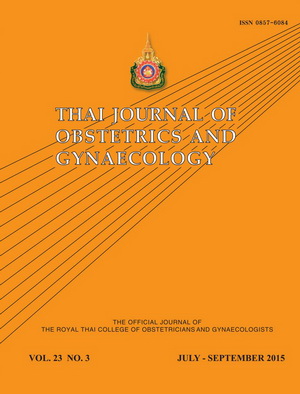Factors Associated with Neonatal Morbidity or Early Neonatal Mortality in Twin Pregnancies at Chonburi Hospital
Main Article Content
Abstract
Objective: To determine the factors contributing to neonatal morbidity and/or early neonatal mortality in twin pregnancies.
Materials and Methods: A case-control study was performed by 220 twin pregnant women who delivered at 28 weeks of gestation or beyond at Chonburi Hospital from March 2012 to January 2014. Cases were 55 twin pregnancies with unfavorable outcomes on both neonates, including neonatal morbidity and/or early neonatal mortality, while controls were 165 twin pregnancies with favorable outcomes on both neonates. Antepartum and intrapartum characteristics were compared between both groups. The associated factors were determined by univariate and multivariate logistic regression model.
Results: Complete data from chart reviewed of 220 twin pregnancies were obtained. These factors including preterm birth before 34 weeks, monochorionicity, premature rupture of membranes (PROM), PROM beyond 18 hours, being referred cases, birth weight discordancy greater than 25% and Apgar score less than or equal to 7 at 1 and 5 minutes were significantly associated to adverse neonatal outcomes (p < 0.05). By the multivariate analysis, preterm birth before 34 weeks and birth weight discordancy more than 25% remained statistically significant (OR 5.65, 95% CI 1.1-3.4, p<0.001 and OR 3.12, 95% CI 2.6-5.7, p<0.001, respectively). No statistically significant difference between 2 groups in maternal complication including pregnancy induced hypertension (PIH), postpartum hemorrhage (PPH) and puerperal infection (urinary tract infection (UTI), wound infection).
Conclusion: Preterm birth before 34 weeks and birth weight discordant more than 25% were associated with neonatal morbidity and/or early neonatal mortality in twin pregnancies.


